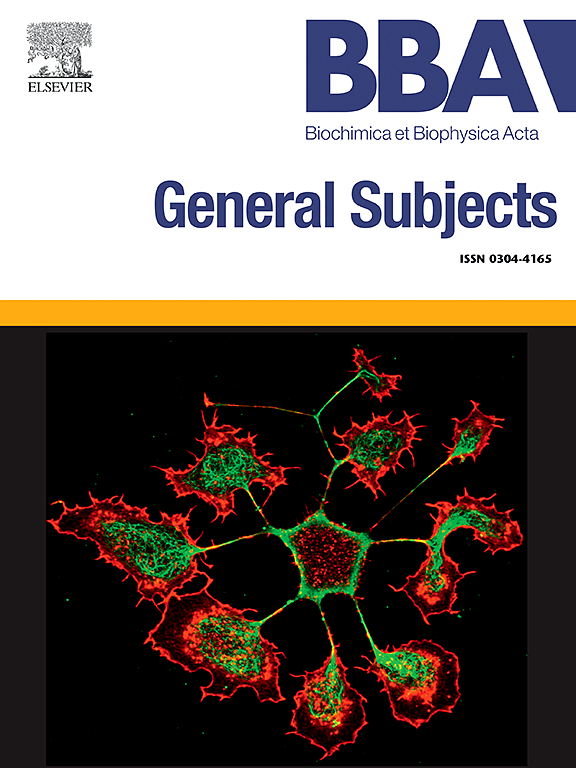植物胁迫中的一氧化氮:重新野生和恢复促进植物生长和发育的信号
IF 2.2
3区 生物学
Q3 BIOCHEMISTRY & MOLECULAR BIOLOGY
Biochimica et biophysica acta. General subjects
Pub Date : 2025-06-20
DOI:10.1016/j.bbagen.2025.130837
引用次数: 0
摘要
植物作为一个复杂的系统,不断地暴露在影响其生长发育,有时甚至影响其生存的环境条件下。它们是不稳定的,在各种环境约束(生物和非生物)的影响下完成其生命周期,这对农产品的质量和生产力产生不利影响。植物已经进化出几种防御策略,这些策略是通过植物激素来协调的,这些激素在赋予植物抵抗压力的能力中起着关键作用。一氧化氮(NO)是一种内源性气体激素,在植物对不同胁迫的反应中起着救星的作用。它在植物的生长发育过程中起着积极的作用,从种子休眠、萌发到生长、分化、开花、结果、成熟,并影响光合作用等关键代谢过程。内源性NO的产生及其通过不同的信号级联与植物激素的相互作用有助于减轻自由基在干旱、盐度和其他胁迫下造成的细胞损伤。它通过诱导乙烯(ET)等应激激素的合成,帮助植物抵御不利的环境约束,最大限度地减少不同胁迫造成的损害,从而有助于抗逆性。外源施用NO通过打破种子休眠和调节萌发、增强矿质营养物质的获取、促进光合作用、产生能够中和自由基的抗氧化酶和维持膜完整性等方式对不同胁迫产生保护作用。一氧化氮在植物抗逆性中的重要作用。本研究对NO的产生方法、参与生长和发育以及其在缓解不同应激中的作用提供了有价值的见解。在目前的情况下,对NO信号机制的持续研究以及与其他途径的相互作用似乎对于利用其潜力开发具有增强环境适应能力的作物至关重要。本文章由计算机程序翻译,如有差异,请以英文原文为准。
Nitric oxide in plant stress: Rewilding and restoring signaling for enhancing plant growth and development
Plants, represented as a complex system, are continuously exposed to environmental conditions that affect their growth and development, and sometimes their survival. Being sessile, they complete their life cycle under the influence of varied environmental constraints (biotic and abiotic), that adversely affect the produce's quality and productivity. Plants have evolved several defense strategies orchestrated through phytohormones that play a pivotal role in conferring resistance to stress. Nitric oxide (NO), an endogenously produced gaseous hormone, has emerged as a saviour in plant's response to different stresses. It plays an active role in the growth and development of plants, from seed dormancy and germination to growth, differentiation, flowering, fruiting, and ripening, besides affecting key metabolic processes such as photosynthesis. Endogenous production of NO and its interaction with phytohormones across different signaling cascades helps in alleviating the cellular damage caused by free radicals during drought, salinity, and other stresses. It contributes to stress resilience by inducing the synthesis of stress hormones such as ethylene (ET), which help plants to withstand adverse environmental constraints by minimizing the damage caused by different stresses. Exogenous application of NO exerts protective effects against different stresses by breaking seed dormancy and modulating germination, enhancing acquisition of mineral nutrients, photosynthetic functioning, production of antioxidant enzymes capable of neutralizing free radicals, and maintaining membrane integrity. These multifaceted roles of NO underscore its significance in plant stress tolerance. The present study offers valuable insights into NO production methods, involvement in growth and development, and a mechanistic view of its role in alleviating different stresses. In the current scenario, continued research into NO signaling mechanisms and cross-talk with other pathways seems essential for harnessing its potential in developing crops with enhanced resilience to environmental challenges.
求助全文
通过发布文献求助,成功后即可免费获取论文全文。
去求助
来源期刊

Biochimica et biophysica acta. General subjects
生物-生化与分子生物学
CiteScore
6.40
自引率
0.00%
发文量
139
审稿时长
30 days
期刊介绍:
BBA General Subjects accepts for submission either original, hypothesis-driven studies or reviews covering subjects in biochemistry and biophysics that are considered to have general interest for a wide audience. Manuscripts with interdisciplinary approaches are especially encouraged.
 求助内容:
求助内容: 应助结果提醒方式:
应助结果提醒方式:


